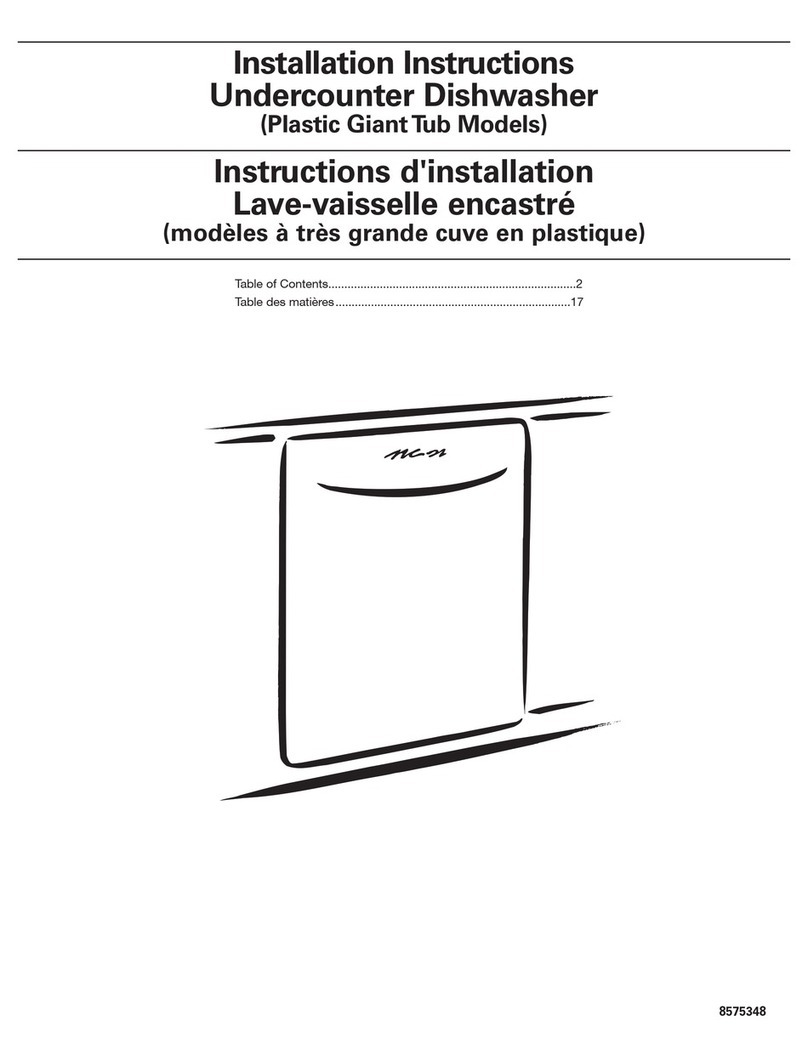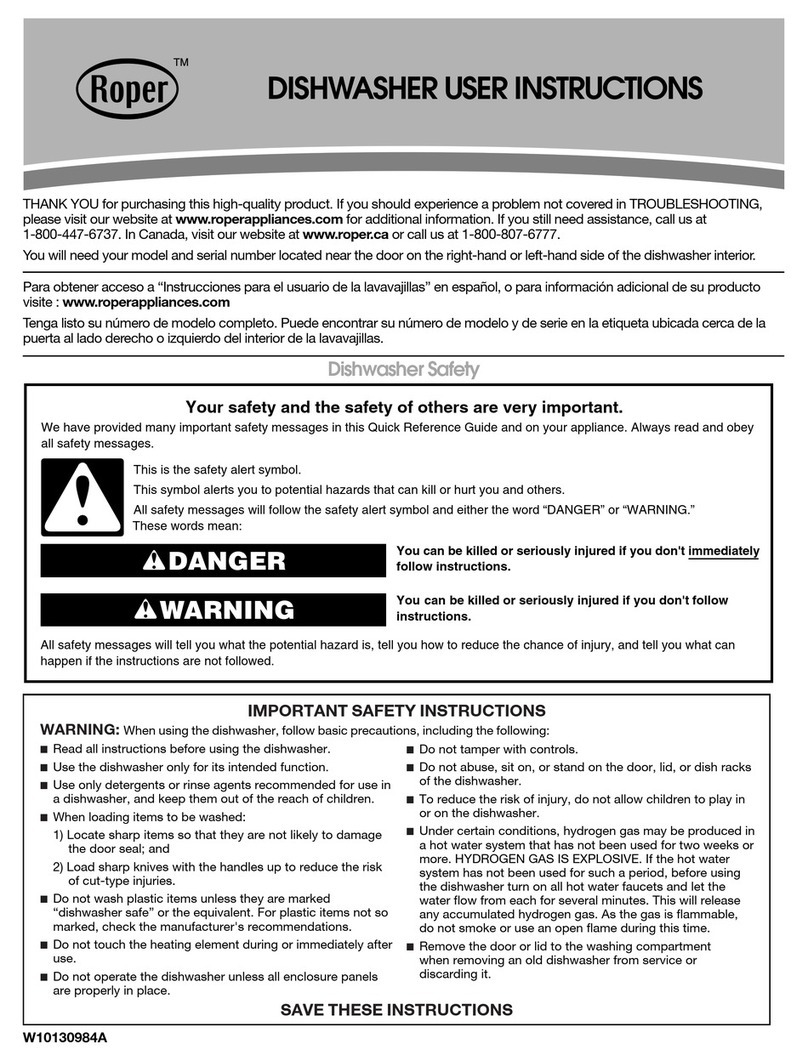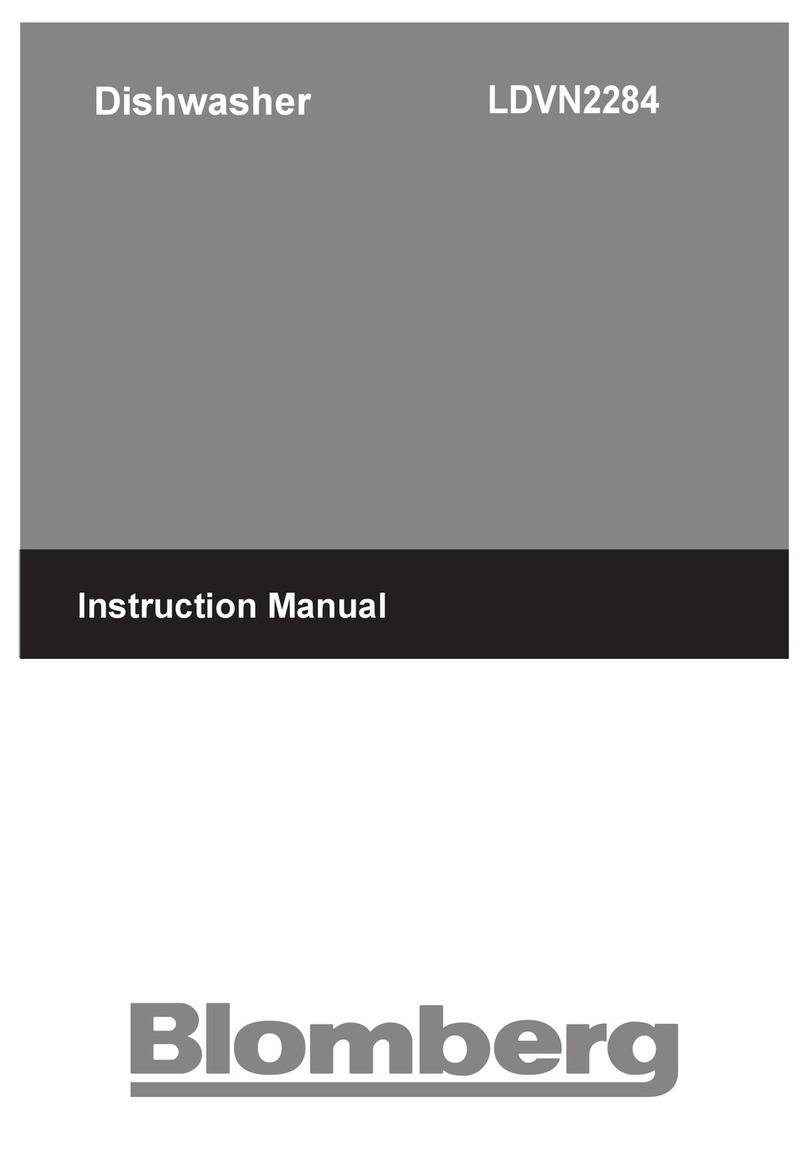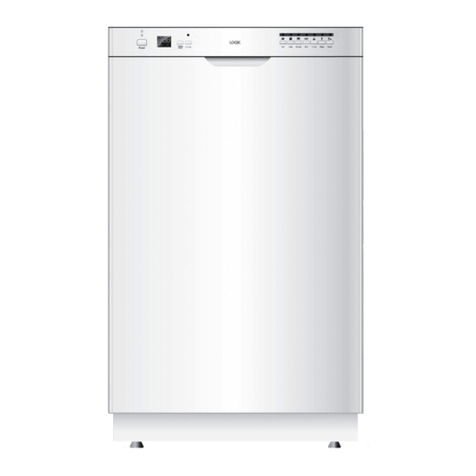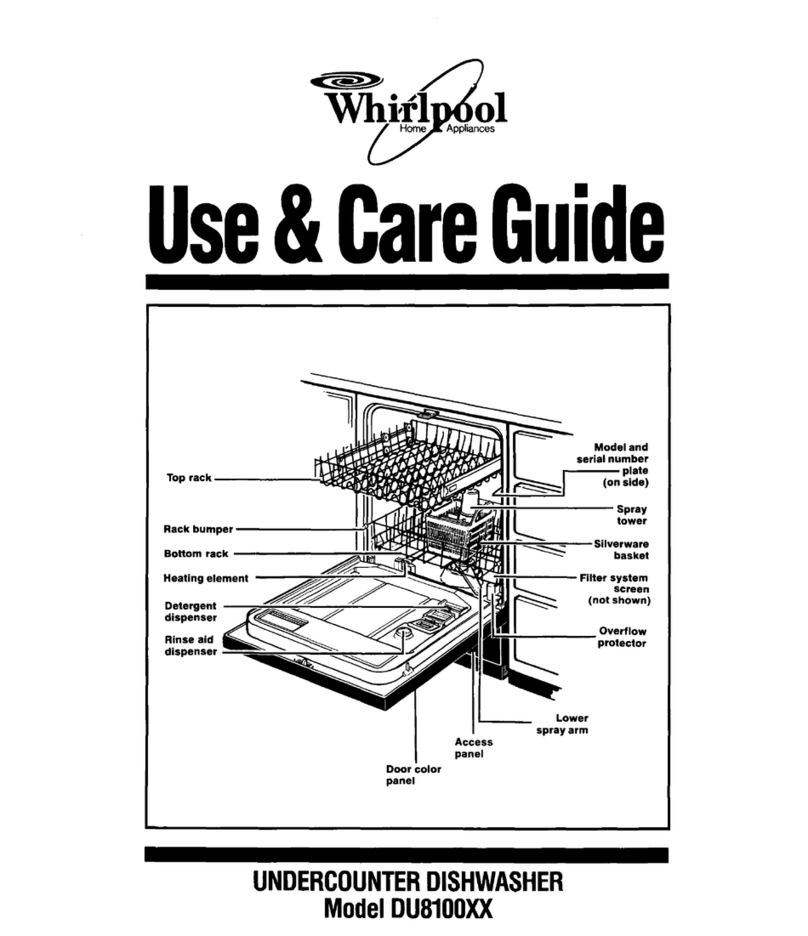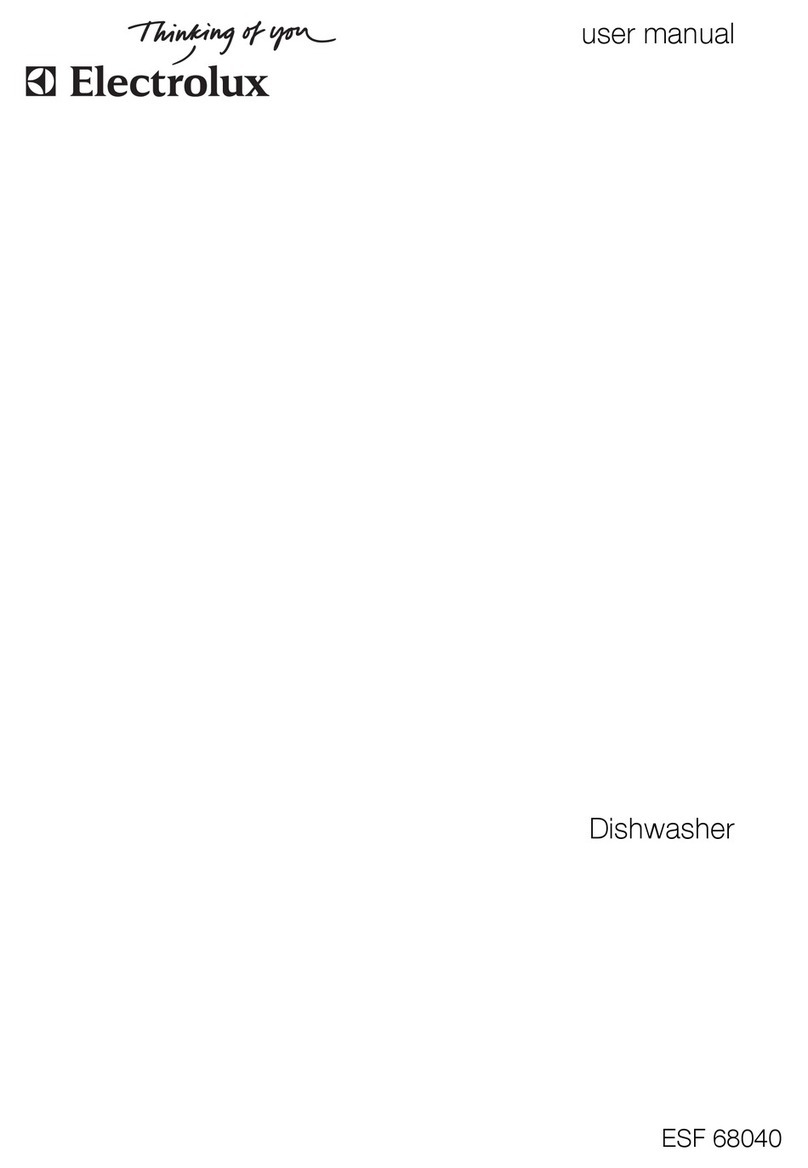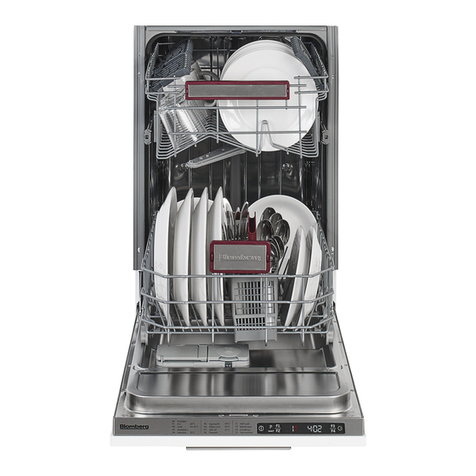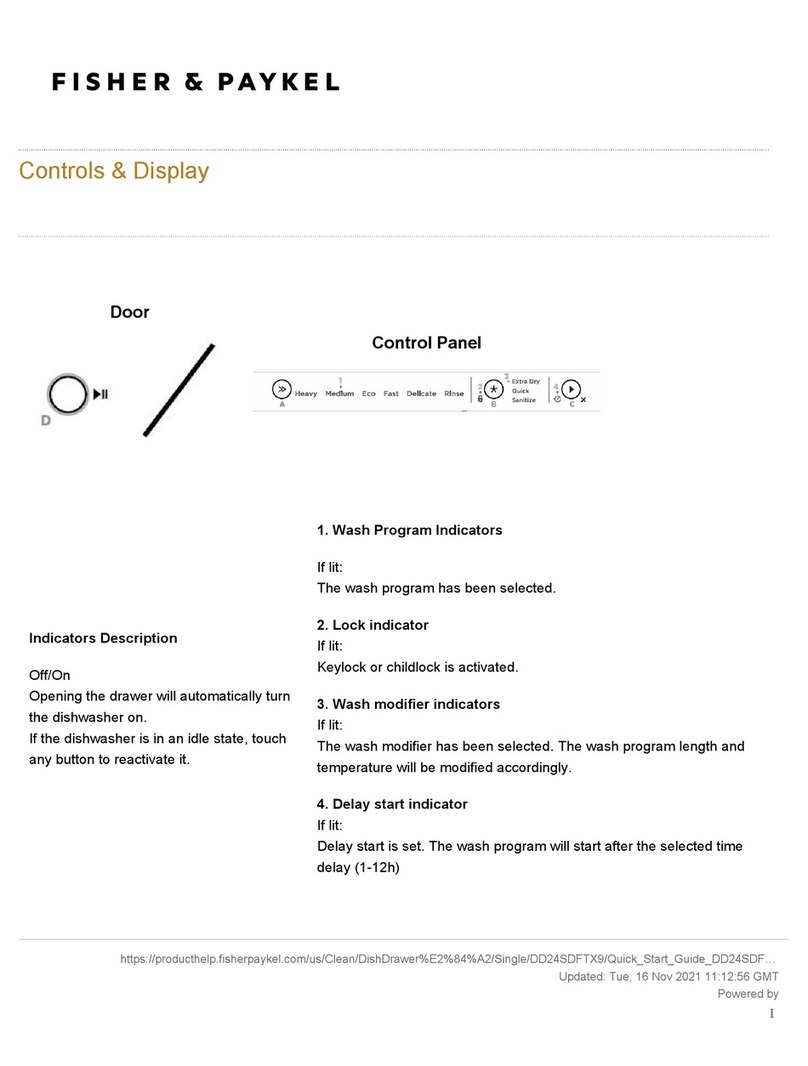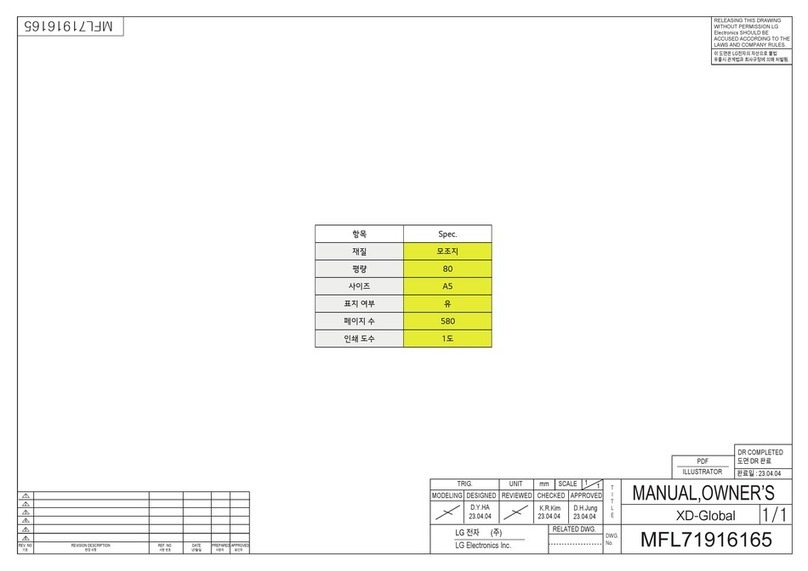Roper RUD3000 User manual

BYWHIRU:_)OLC(:T4PORATION
®
UNDERCOUNTER
DISHWASHER
Use &Care Guide
Forquestionsaboutfeatures,opecation/pedonnence,parts,access(_'iesorsen4ce,
ca,: 1-800-44-ROPER (1-800-447-6737)
InCanada,for asldstance,call:1-800.-461-54181,forInstallation
and se_ce call:1-800-807-6777
o_ visit o_ website at..
www.roperap_llmceL¢onl
LAVE-VAISSELLE
ENCASTRE
Guide d'utilisationetd_entretien
Au Canada, pouressistance,
composerle 1-8Q0-461_681,
pourl_tallat_on_ servicele1-800-807-41777
ou vl_ notresiteweb k
Table of corrtents/Table des mati_res ......................................... 2
,i, ,u,, i-
Models/Modbles RUD1000, RUD3000, RUDS000, RUD5750
8051567

TABLEOFCOI I NTS
DISHWASHER SAFETY ............................................................ 3
Before Using Your Dishwasher .................................................... 4
PARTS AND FEATURES ........................................................... 5
Control Panels .............................................................................. 6
START-UP GUIDE .......................................................................... 7
Using Your New Dishwasher ....................................................... 7
Stopping Your Dishwasher .......................................................... 7
DISHWASHER LOADING .............................................................. 7
Loading Suggestions ................................................................... 7
Loading the Top Rack .................................................................. 8
Loading the Bottom Rack ............................................................ 8
Loading the Silverware Basket .................................................... 9
DISHWASHER USE ....................................................................... 9
Detergent Dispenser .................................................................... 9
Rinse Aid Dispenser ................................................................... 10
Dishwasher Efficiency Tips ........................................................ 11
Cycle Selection Chart ................................................................ 11
Canceling a Cycle ...................................................................... 12
Changing a Cycle or Setting ...................................................... 12
Adding Items During a Cycle ..................................................... 12
Option Selections ....................................................................... 12
Drying System ............................................................................ 13
Overfill Protection Float.............................................................. 13
WASHING SPECIAL ITEMS ........................................................ 13
DISHWASHER CARE ................................................................... 14
Cleaning Your Dishwasher......................................................... 14
Cleaning the Filter Screen .......................................................... 14
DraJnAir Gap .............................................................................. 15
Storing Your Dishwasher ........................................................... 15
TROUB_OOTING ............................................. .. ................ 15
ASSISTANCE OR SERVICE ...................................................... 17
in the U.S3_. ............................................................................... 17
In Canada ................................................................................... 17
WARRANTY .......................................................................... 18
TABLEDESMATI :RES
LA SI_CURITI_ DU LAVE-VAISSELLE ..................................... 19
Avant d'utilleer te lave-valaselle ................................................. 20
PU_CES ET CARACTli_RISTIQUES ........................................... 21
Tableaux de commande ............................................................ 22
GUIDE DE MISE EN MARCHE ................................................ 23
Utilisation de votre nouveau lave-valeselle ................................ 23
An_t du lave_vaisse, e ................................................................ 23
CHARGEMENT DU LAVE-VAISSELLE ...................................... 23
Suggestions de chargoment ...................................................... 23
Chergement du partier sup_rieur ............................................... 24
Chergement du panler inf_rieur ................................................. 24
Chergement du partier bcouverts ............................................. 25
UTILISATION DU LAVE-VAISSELLE ......................................... .25
Distributeur de d_tergent ........................................................... 25
Distributeur d'agant de rir_s_ge.................................................. 26
Conseiis d'efficacit(_ pour le lave-vaiaselle ................................ 27
Tableau de s6lection de programme ......................................... 27
Annulation d'un programme ...................................................... 28
Chengement d'un programme ou r6glage ................................ 28
Addition de vaiaselle durant un programme .............................. 28
S61ectiond'options ..................................................................... 28
Syst_ne de s6chage .................................................................. 29
Dispositif de protection contre le di_bordement ........................ 29
LAVAGE D'ARTICLES SPI_ClAUX ............................................. 30
ENTRETIEN DU LAVE-VAISEELLE ........................................... 31
Nettoyage du lave-vaisse_le....................................................... 31
Nettoyage de 1'6cmn de filtre..................................................... 31
Dispositif anti-refoulement ......................................................... 31
Remisage du lave-vaisselle ........................................................ 31
DIEPANNAGE .............................................................................. 32
ASSISTANCE OU SERVICE ...................................................... 34
GARAN°nE °_°_=_=-`_`_°_°°_=_°_`_`=_```_`_°=_`_*_`_`_°_=°_``_`°_°_3_
2

Ii ! •
DISHWASHERSAFEW
Your safety and the safety of others are very important.
We have provided many important safety messages in this manual and on your appliance. Always read and obey all
safety messages.
This isthe safety alert symbol.
This symbol alerts you to potential hazards that can killor hurt you end others,
All safety messages willfollow the safety alert symbol and either the word "DANGER" or
WVARNING," These words mean:
You can be killed or seriously injured if you don't
Immedl0tely follow instructions.
You can be killed or seriously injured if you don't
follow Instructions.
All safety messages will tell you what the potential hazard is, tell you how to reduce the chance of injury, and tell you
•what can happen if the instructions are not followed.
IMPORTANT SAFETY INSTRUCTIONS
WARNING: When using the dishwasher, follow basic precautions, including the following:
•Read all instructions before using the dishwasher.
•Usa the dishwasher only for its intended function.
•Use only detergents or dnse agents recommended
for use in a dishwasher, and keep them out of the
reach of children.
•When loading items to be washed:
1) Locate sharp items so that they are not likely to
damage the door seal; and
2) Load sharp knives with the handles up to reduce
the risk of cut-type injudes.
•Do not wash plastic items unlessthey are marked
=dishwasher safe" or the equivalent. For plastic
items not so marked, check the manufacturer's
recommendstions.
• Do not touch the heating element dudng or
immediately after use.
•Do not operate the dishwasher unless all enclosure
panels are properly in place.
• Do not temper with controls.
• Do not abuse, sit on, or stand on the door or dish
racks of the dishwasher.
•To reduce the risk of injury, do not allow children to
play in or on the dishwasher.
Under certain conditions, hydrogen gas may be
produced in a hot water system that has not been
used for two weeks or more. HYDROGEN GAS IS
EXPLOSIVE. Ifthe hot water system has not been
used for such aperiod, before using the dishwasher
turn on all hot water faucets and let the water flow
from each for several minutes. This willrelease any
accumulated hydrogen gas. As the gas isflammable,
do not smoke or use an open flame during this time.
•Remove the door to the washing compartment when
removing an old dishwasher from service or
discarding it.
SAVETHESE INSTRUCTIONS

Before UsingYour Dishwasher
Tip Over Hazard
Do not use dishwasher until completely Installed.
Do not push down on open door.
Doing so can result in serious Injury or cuts.
Electrical Shock Hazard
Electrically ground dishwasher.
Connect ground wire to green ground connector
in terminal box.
Do not use an extension cord.
Failure to follow these instructions can result In
death, fire, or electrical shock.
GROUNDING INSTRUCTIONS
•For a grounded, cord-connected dishwasher:.
The dishwasher must be grounded. In the event
of a malfunction or breakdown, grounding will
reduce the risk of electdc shock by providing a
path of least resistance for electric current. The
dishwasher is equipped with a cord having an
equipment-grounding conductor and a grounding
p!ug. The plug must be plugged into an appro-
priate outlet that is installed and grounded in
accordance with all local codes and ordinances.
WARNING: Improper connection of the
equipment-grounding conductor can result in a
risk of electric shock. Check with a qualified
electrician or service representative if you are in
doubt whether the dishwasher is properly
grounded. Do not modify the plug provided with
the dishwasher; if it will not fit the outlet, have a
proper outlet installed by a qualified electrician.
=For a permanently connected dishwasher:
The dishwasher must be connected to a
grounded metal, permanent wiring system, or an
equipment-grounding conductor must be run
with the circuit conductors and connected to the
equipment-grounding terminal or lead on the
dishwasher.
SAVE THESE INSTRUCTIONS
Install where dishwasher is protected from the elements.
Protect against freezing to avoid possible rupture of fill valve.
Such ruptures are not covered by the warranty. See "Stodng
Your Dishwasher" in the "Dishwasher Care" section for winter
storage information.
Install and level dishwasher on a floor that will hold the
weight, and in an area suitable for its size and use.
Remove all shipping plugs from hoses and connectors (such
as the cap on the drain outlet) before installing. See
Installation Instructions for complete information.
4

PARTSAND FEAIURES
Thismanualcoversseveraldiffererrtmodels._dishwasheryou havepurchasedmayhavesomeor eliof thepartsand featureslisted
below.
8
29
4
5
11
12
13
614
15
1. Third level wash [on some models]
2. Top rack
3. Water inlet opening [intub wall]
4. BoSom rack
5. Rack bumper
6. Heating elerrlerlt
7. Vent
8. Extra-capacity fold-down shelves
Ionsomem,xleis)
9. Spray tower and protector
10. Model and seriel number label
11. Silverware basket
12. Sprayarrn
13. Overfill protection float
14. Detergent dispensers
15. Rinse aid dispenser

Control PQnels
Model RUD1000
Model RUD3000
ORy mLl.ic'r
m
ore,
Model RUDS000
m ia,
I_0"_ &_
Model RUD5750
I1,11__
6

START-UPGUIDE
Before using your dishwasher, remove ell packaging materials.
Read this entire Use and Care Guide. You will find important
safety information and useful operating tips.
Using Your New Dishwasher
1. Scrape large food soil and hard items (toothpicks or bones)
from dishes.
2. Propedy load the dishwasher. (See "Dishwasher Loading.")
Make sure nothing prevents the spray arm(s) from spinning
freely.
3. Add detergent and check the rinse aid dispenser. AdO rinse
aid if needed. (See "Dishwasher Use.")
•...I;<
4. Push door firmly closed. The door latches automaUcelly. Run
hot water at the sink nearest your dishwasher until the water
is hot. (See "Dishwasher Efficiency "13ps.")Turn off water.
5. Select the desired cycle. (See "Dishwasher Use.")
6. Select the desired option. (See "Option Selections.")
ml
Stopping YourDishwasher
You can stop your dishwasher anytime during a cycle.
1. Open the door slightly.
2.. Wait for the spraying action to stop. Then open the door ell
the way, if needed.
3. Close the door to continue the cycle.
OR
1. Turn the Cycle Control knob slowly clockwise until you hear
water draining. Let the dishwasher drain completely.
2. Open the door.
3. Turn the Cycle Control knob to OFF.
DISHWASHERLOADING
Loading Suggestions
Remove leftover food, hones, toothpicks and other hard
items from the dishes. It is not necessary to rinse the dishes
before putting them in the dishwasher.
NOTE: if hard items such as fruit seeds, nuts, and egg shells
enter the wash system, you might hear chopping, grinding,
crunching, or buzzing sounds. These sounds are normal. Do
not let metallic items (such as pot handle screws) get into the
wash system. Damage can occur.
• Load dishes so soiled surfaces face the spray (down or
inward). It is important for the water spray to reach all soiled
surfaces.
•Load dishes so they are not stacked or overlapping if
possible. For best drying, water must be able to drain from all
surfaces.
• Makesure potlidsand handles,pizzapans,cookiesheets,
etc., do not interferewith thesprayarmrotation.
Runa rinsecycle tokeep dishesmoistif youdo notplanto
washthem soon.Foodslikeeggs,rice,pasta, spinach,and
cookedcerealsmay he hardto removeiftheyare left to dry
overa pedod oftime.
Quitopaa g
To avoid thumping/clattering noises dudng operation:
•Make sure lightweight load items are secured in the racks.
•Makesurepot lids end handles,pizzapans,cookiesheets,
etc., do nottouchinteriorwallsorinterferewiththe rotationof
the sprayarm.
•Load dishes so they do not touch one another.
NOTE: For built-in models, keep sink drain plugs closed dudng
dishwasher operation to prevent noise transfer through drains.
7

Loading the Top Rack
top rack isdesignedfor cups,glasses,and smalleritems.
(Seerecommendedloadingpatternsshown.)
NOTE: The featureson yourdishwasherrackmay varyfromthe
drawingsshown.
Do not coverthirdlevelwash(on somemodels).See arrow.
Cup and glass load
Loadingthe BottomRack
The bottom rack is designed for plates, pans, _as, and
utensils, items with cooked-on or dried-on food should be loaded
with soiled surfaces facing inward to the spray. (See
recommended loading patterns shown.)
NOTE: The features on your dishwasher rack may vary from the
drawings shown.
Do not cover spray tower. See arrow.
Mixedtoad
•Place items so open ends face down for cleaning and
draining.
•Load glasses and cups in top rack only. The bottom reck is
not designed for glasses and cups. Damage can occur.
•Place cups and glasses in the rows between tines. Placing
them over the itnas can lead to breakage and water spots.
•To avoid chipping, do not let stemware touch other items.
•China, crystal, and other delicate items must not touch each
other during dishwasher operation. Damage can occur.
•Wedge lightweight items against one another or overlap them
with heavier dishes.
•Load plastic items securely in the top rack only. Wash only
plastic items marked =dishwasher safe."
•Small bowls, pans, and other utensils can be placed in the
top rack. Load bowls in the center section for best stability.
Extra-capacity fold-down shelves
(onsomemode )
Fold down the extra shelf on the top rack to hold additional cups,
or long items such as utensils and spatulas.
Mixed load
Do not load glasses, sups, or plastic items inthe bottom
rack. Load small items in the bottom rack only if they are
secured in place.
Loadplates,soupbowls,etc., betweentinesand facing
inwardto the spray.
Overlapthe edgesofplates for largeloads.
Load soup, cereal, and serving bowls in the rack in a variety
of ways depending upon their size and shape. Load bowls
securely between the rows of tines. DO not nest bowls
because the spray will not reach all surfaces.
Utensil _ad
Load cookie sheets, cake pans, and other large items at the
sides and beck. Loading such items in front can keep the
water spray from reaching the detergent dispenser and
silverware basket.
•Secure heavily soiled cookwere face down in the reck.
•Make surepot handlesand otheritemsdo not stoprotation
ofthesprayarm(s)._sprayerm(s)mustmovefreely.
• DO not load items between the bottom rack and the side of
the dishwasher tub. You can block the water inlet opening.
NOTE: If you have removed the bottom rack for unloading or
cleaning, replace it with the bumpers in front.
8

Loading the Silverware Basket
Load the silverware basket while it is in the bottom rack or take
the basket out for loading on a counter or table.
NOTE: Unload or remove the basket before unloading the racks
to avoid spilling water droplets on the silverware.
Style 1
(on some models)
Stldo 2
(on some models)
Mix items in each section of the basket with some pointing up
and some down to avoid nesting. Spray cannot roach nested
items.
IMPORTANT:. Always load sharp items (knives, skewers, etc.)
pointing down.
NO'rl_:
•Do not load silver or silver-pleted silverware with stainless
steel. These metals can be damaged by contact with each
other dudng washing.
•Some foods (such as salt, vinegar, milk products, fruit juices,
etc.) can pit or corrode silverware. Run a dnse cycle if you do
not have a full load to wash immediately.
DISHWASHERUSE
Detergent Dispenser
The detergent dispenser has 2 sections. The Pre-Wash section
empties detergent into the dishwasher when you close the door.
1. Cover
2. Main wash section
3. Cover latch
4. Pre-wash section
The Main Wash section automatically empties detergent into the
dishwasher dudng the main wash. (See the "Cycle Selection
Chart.")
•Use automatic dishwashing detergent only. Other detergents
can produce excessive suds that can overflow out of the
dishwasher and reduce washing performance.
•Add detergent just before starting a cycle.
•Store tightly closed detergent in a coot, dry place. Fresh
automatic dishwasher detergent results in better cleaning.
NOTE: Do not use detergent with a dns_ cycle.
Riling I_e dispenser
1. If the dispenser cover is closed, open the cover by pushing
the Cover latch.
2. RII the Main Wash section with detergent. See "How Much
Detergent to Use."
3. Close the Main Wash dispenser cover. Fillthe Pre-Wash
section if needed.
It is normal for the cover to open partially when dispensing
detergent.
NOTE: Use both sections for cycles with 2 washes. Use only the
covered section for cycles with 1 wash. See the =Cycle Selection
Chart" for more details.

Howmuchdetergentto use
Iz The amount of detergent to uea depends on the herdnass of
your water and the type of detergent, ff you use too retie,
dishes won't be clean. If you use too much in soft water,
glassware will etch.
mWater hardness can change over a pedod of time. Find out
your water's hardness by asking your local water department,
water softener company, or county extension agent.
Different brands of dishwasher detergent have different
amounts of phosphorous for softening water. If you have hard
water and use a detergent with a phosphorous content of
less than 8.7%, you might need to use more detergent, or use
a detergent with a phosphorous content higher than 8.7%.
Where to fill
Topof3rd step (3tbs or 45 g)
Topof 2nd step(2tbs or 30 g)
Topof 1st step(1 tb or 15 g)
n., _ I in, ,
Water Hardness Amount of Detergent
Soft to Medium
Hard Water
0 to 6 grains per
g=k
For normally soiled loads
• Fill the Main Wash ssctJon to the
top of the 2nd step (2 tbe or 30 g)
•Fill the Pre-Wash section to the
top of the 2nd step (2 tbs or 30 g)
If needed
NOTE: Add only 1 tb or 15 g of
detergent to both sections If dishes
are pre-dnssd or the water is very
soft (0 to 2 grains per gallon).
Fo_ heavily soiled loads
•Fillthe Main Wash section to the
top of the 3rd step (3 tbe or 45 g)
•Fillthe Pre-Washsectionto the
top ofthe 2ridstep (2 tbsor 30 g)
Medium to Hard
Water
7 to 12 grainsper
gallon
For nonnatly soiled and
heavily soiled loads
•Fill the Main Wash section to the
top of the 3rd step (3 tbs or 45 g)
•Fillthe Pre-Wash section to the
top of the 2nd step (2 tbs or 30 g)
if needed
i
NOTE: Fillamounts shown are for standard powdered detergent.
Amounts may vary if you use liquid or concentrated powdered
detergent. Follow instructions on the package when using liquid
dishwasher detergent or concentrated powdered detergent.
RinseAid Dispenser
Rinse aids ixevent water from forming droplets that can dry as
spots er streaks. They also improve drying by allowing water to
drain off of the dishes during the final rinss by rek_ng asmall
amount of the rinse aid into the rinss water. Your dishwasher is
designed to use a liquid rinse aid. Do not use a solid or ber-type.
Cheofdngthe d_nser
Check the center of the Fill Indicator cap. Clear means it needs
filling.
Or you can remove the Fill Indicator cap. If an "E" is visible, the
dispenser is empty.
RHing the dispenser
The rinse aid dispenser holds 6 oz (175 mL) of rinse aid. Under
normal conditions, this will last for about three months. You do
not have to wait until the dispenser is empty to refillit. Try to keep
it full, but be careful not to overfill it.
1. Make sure the dishwasher door is completely open.
2. Remove the Fill Indicator cap.
3. Add rinse aid. Fillto the smalleat opening in the lower part of
the dispenser. Overfilling can cause the rinse aid to leak out,
and could cause oversudsing.
4. Clean up any spilled rinse aid with e damp cloth.
5. Replace the Fill Indicator cap. Close tightly.
10

Dishwasher Efficiency
Hot water dissolves and activates the dishweshlng detergent.
Hot water also dissolves grease on dishes and helps glasses dry
spot-free. For best dishweshing results, water must be at least
120°F (49°C) as it enters the dishwasher. Loads may not wash as
well if the water temperature is too low.
To check water temperature
1. Run hot water at the faucet closest to your dishwasher for at
least I minute.
2. Place a candy or meet thermometer in a glass measuring
cup.
3. Check the temperature on the thermometer as the water is
running into the cup.
4. Ifthe water temperature at the faucet is below 12(T'F (49°(3),
have a queliflsd person raise the water beater's thermostat
setting.
•To save water, energy and time, do not rinse dishes before
putting them into the dishwasher.
• Use alow energy, quick, or short cycle whenever possible.
These cycles use less hot water and anengy than the Normal
cycle.
•Useadelayfeature(onsomemodels)to runyourdishwasher
dudngoff-peak hours.Localutilities recommendavoiding
heavyusage ofenergyat certaintimesof day.
•Duringthe summer,runyourdishwasherat night.This
reducesdaytimeheatbuildupinthe kitchen.
•Usethe energysavingdryoptionwheneverpossible.Allow
longerdryingtimes(overnight)whenusingtheseoptions.Use
a dnssaid to improvedrying.
•Use cycles or options that add extra heat to the wash or dnse
portion of the cycle only when needed.
•Run your dishwasher with full loads. Run a rinse cycle after
meals until the dishwasher isfull.
Cycle Selection(3hod
Selectthe washcycle.If the doorislatched, youwill he_ the
cyclasstartand stop as theCycleControlknobpessssesch
cyclemark.Thisisnormaland doesnothurtthe dishwasher.If
you prefer,you cansetthe CycleControlknobwiththedoor
unlatched.
NOTE: Use the Energy-Saver Dry option with the Rinse & Hold
cycle (on some models).
Models with a rocker switch:
Turn the Cycle Control knob to the desired cycle.
Models with 5 or 7 pads:
Press the desired cycle. Turn the Cycle Control knob to the
desired cycle. To use Rinse & Hold, press any cycle and turn the
Cycle Control knob to RINSE & HOLD.
A "e" shows what steps are in each cycle. Your model may have
some or all of the cycles shown.
Water usage is shown in U.S. gellonsAiters.
Cycle time includes dry time.
Use this cycle for herd-to- Use both
clean, heavily-soiled pots, detergent
pans, casseroles, end dispenser
regular tableware, sections.
Wash Rinse Rinse • ain Rinse Final Dry
Wash Rinse
Use this cycle for loads
with heavy food soil. Use both
detergent
dispenser
sections.
Wash RiMe Rinse
Usethis cycle forloads
withnormalamountsof
foodsoil. (Theanergy-
usagelabelisbasedon
thiscycle.)
Use both
detergent
d_nser
_ona,
Wash Rinse Rlmle Main Rinse Final
Wash Rknse
11

Usethiscyclefor pre- Use
dnsed or lightlysoiled covered
loads, detergent
dispenser
section.
Wash Rinse Rinse Main Rinse Final Dry Time Water
Wash Rinse (rain) _._l/L)USage
•••••.S.7/21.a
Use this cycle for rinsing Do not use
dishes, glasses, and detergent
silverware that will not be with this I I
washed right away. cycle.
Wash Rinse Rinse Main Rinse Final Dry Time Water
Wash Rinse (mln) Usage
(011/L)
20 2.9/10.1
Canceling a Cycle
You can cancel a cycle at any time.
1. Turn the Cycle Control knob slowly clockwise until you hear
water draining. Let the dishwasher drain completely.
2. Open the door.
3. Tum the Cycle Control knob to OFF.
Changing a CycleorSetting
If your dishwasher has mere than one wash cycle, you can
change a cycle anytime during a cycle.
1. Liftthe door latch to stop the cycle.
2. Turn the Cycle Control knob clockwise.
3. Check the detergent dispensers, l_ley must be filled properly
for the new cycle.
NOTE: Turning the Cycle Control knob can cause the covered
Detergent Dispenser section to open and release the
detergent. Check the covered section if the cycle uses
detergant in both sections.
4. Close the door firmly until it latches. "l_e dishwasher starts a
new cycle.
Adding Items During a Cycle
You can add an item anytime before the main wash starts, or the
Cycle Control knob reaches Ught Wash.
1. Lift up the door latch to stop the cycle. Wait for the spraying
action to stop before opening the door.
2. Open the door and add the item.
3. Close the door, but do not latch it. Wait 30 seconds for the air
in the dishwasher to warm up. This reduces the amount of
moisture escaping from the vent when restarting a cycle.
4. Close the door firmly until it latches. The dishwasher resumes
the cycle.
OptionSeleclions
Youcanchangean optionanytime before the selectedoption
begins.Forexample,youcan pressan unheated dryingoption
any timebefore dryingbegins.
Energy Saver Dry
Select this option to dry dishes without heat and save anergy.
The dishes take longer to dry and some spotting can occur.
--'-= _v
P._'4ER I_Y
OR
For best drying, use a liquid dnse aid. Some items (such as
plastics) may need towel dcying.
NOTE: Energy Sever Dry is an option with all cycles except Rinse
& Hold (on some models).
HeatedD,y
Select this option to dry dishes with heated air. For best drying
results, use a liquid dnse aid and heated drying.
OR
NOTE: Heated Dry is an option with all cycles except Rinse &
Hold (on some models).
For Model 5750: To select Heated Dry, press RESET OPTIONS.
LowEnegyWaYne (modeS7S0only)
Select this low energy washing option to reduce water
temperature dudng the main wash and final dnse. This will reduce
the amount of electdcity needed to run the dishwasher.
tOWEIIRQY
I
NOllE: Low Enegy Washing (model5750 only)isan option
withallcycles.
ResetOpt ns (modeSTS0
Select this option to change an option setting.
OlqtONs
You can change option settings anytime during a cycle as long as
the cycle has not passed the point where the option is used. For
example, you can press Energy Sever Dry anytime before the
Cycle Control knob reaches Dry.
1. Press RESET OPTIONS.
2. Press I or more options.
12

Delay Houm (on some models)
Select this option to run your dishwasher at alater time or during
off-peak hours.
Tod_ay thetort
1. Close the door.
2- Select awash cycle and option. Press the desired cycle. Tum
the Cycle Control knob clockwise to the number of heurs you
want the dishwasher to delay the start.
The dishwasher starts the cycle in the selected number of
hours. You can add items while the time is counting down.
3. Close and latch the door. The Cycle Control knob will not
advance if the door is unlatched.
NOTES:
•To cancel the delay, turn the Cycle Cootrol knob to the
desired cycle.
•Rinse & Hold and the Ught Wash cycles (on some models)
cannot be delayed.
IMPORTANT:
• Operate your dishwasher only when you am at home.
• If your home is equipped with a water softener, do not start
the dishwasher during the regeneration of the softener.
Drying System
Dudng drying, you can see steam escaping through U'mvent at
the upper left corner of the door. This is normal as the heat ddes
your dishes.
IMPORTAN'F:The vaper is hot.Do nottouchthe vant
duringdrying.
Overfill Protection Float
The overfill protection float (in the front right comer of the
dishwasher tub) keeps the dishwasher from overfilling. It must be
in place for the dishwasher to operate.
Check underthefloat for objectsthat maykeepthe protector
frommovingup or down.
WASHING ill,MS
if you have doubts about washing a particular item, check with
the manufacturer to see if it is dishwasher safe.
Material Dishwasher Safe?/Comments
Aluminum Yes
High water temperature and datergents
can affect finish of anodized aluminum.
Disposable No
Aluminum Do not wash throwaway aluminum pans
in the dishwasher. These might shift
dudng washing and transfer black marks
to dishes and other items.
Bottles and Cans No
Wash bottles and cans by hand. Labels
attached with glue can loosen and clog
the spray arms or pump and reduce
washing performance.
Cast Iron No
Seasoning will be removed and iron will
rust.
China/ Yes
Stoneware Always check manufacturer's
recommendations before washing.
Antique, hand-painted, or over-the-glaze
patterns may fade. Gold leaf can discolor
or fade.
Crystal Yes
Check manufacturer's recommendations
before washing. Some types of leaded
crystal can etch with repeated washing.
Gold No
Gold-colored flatware will discoler.
Glass Yes
Milk glass yellows with repeated
dishwasher washing.
Hollow-Handle No
Knives Handles of some knives are attached to
the blade with adhesives which can
loosen if washed in the dishwasher.
Pewter, Brass, No
Bronze High water temperatures and detergent
can discolor or pit the finish.
Disposable No
Plastics Cannot withstand high water
temperatures and detergents.
Plastics Yes
Always check manufacturer's
recommendations before washing.
Plastics vary in their capacity to withstand
high temperatures and detergents. Load
plastics in top reck only.
.13

Material Dishwasher Safe?IComments
Stainless Steel Yes
Run a rinse cycle if not washing
immediatety. I_olong_l contact w_ food
containing asJt, vinegsr, milk products, or
fruit juice can damage finish.
Sterling Silver or Yes
Silver Plate Run a rinse cycle if not washing
immediately. Prolonged contact with food
containing salt, ack:l, or sut_le (eggs,
mayonnaise, and seafood) can damage
finish.
Tin No
Can rust.
Wooden Ware No
Wash by hand. Always check
manufacturer's instructions before
washing. Untreated wood can warp,
crack, or lose its finish.
DISHWASHERCARE
Cleaning Your Dishwasher
theex 'for
In most cases, regular use of asoft, damp cloth or sponge and a
mild detergent is all that is necessary to keep the outside of your
dishwasher looking nice and clean.
Cleaning the interior
Hard water minerals can cause a white film to build up on the
inside surfaces, aspecialty just beneath the door area.
Do not clean the dishwasher interior until it has cooled. Wear
rubber gloves. Do not use any type of cleanser other than
dishwasher detergent because it may cause foaming or sudsing.
To olean interior
Make a paste with powdered dishwasher detergent on a damp
sponge and clean.
OR
Use liquid automatic dishwasher detergent and clean with a
damp sponge.
OR
See the vinegar rinse procadure in _Spotting end filming on
dishes" in "Troublashooting."
NOTE: Run a Wash or Normal Wash cycle with detergent after
cleaning the interior.
Cleaning the FilterScreen
The filter system requires periodic cleaning as needed.
To clesn screen
1. Unload the bottom rack. Slide the rack forward or remove the
rock to reach the filter screen.
2. Remove collected particles from the screen with your fingers
or a paper towel.
3. Replacethe 10ottomrackwiththe rackbumpersfacingthe
door.
NOTE: Do not clean thedishwasherintedoruntilit hascooled.
14

Drain AirGap
Check the dram alr gap anylime your dbhwasher is#t
dralnlngweL
Some state or local plumbing codes require the edditlon of a
drain air gap between a built-in dishwasher and the home drain
system. If a drain is clogged, the drain air gap protects your
dishwasher from water backing up into it.
The drain air gap is usually located on top of the sink or
countertop neer the dishwasher. To order a drain air gap contact
your local dealer, or in the U.S.A., call the Customer Interaction
Center and ask for Part Number 300096.
NOTE: The drain air gap isan external plumbing device that is
not part of your dishwasher. The warranty provided with your
dishwasher does not cover service costs directly associated with
the cleaning or repair of the external drain air gap.
To clean the drain air gap
Clean the drain air gap periodically to ensure proper drainage of
your dishwasher. Follow the cleaning instructions provided by the
manufacturer. With most types, you lift off the chrome cover.
Unscrew the plastic cap. Then check for any soil buildup. Clean if
necessary.
StoringYourDishwasher
St0dng for the sumrner
Protect your dishwasher dudng the summer months by turning
off the water supply and power supply to the dishwasher.
Wtl_edzingyourdishwash_
Protect your dishwasher end home against water damage due to
freezing water lines. If your dishwasher is left in a seasonal
dwelling or could be exposed to near freezing temperatures, have
your dishwasher winterized by authorized service personnel.
1ROUBLESHOOTING
Rmt _the solutimmwgges_KI heremKIpa_iMy avoid
Ihe co_ of a_ndce c_L..
DL_w_J_r mnot operaUngpropedy
• Dishwasher does not run or stops during acycle
Is the door closed tightly and latched?
Is the right cycle selected? Refer to the "Cycle Selection
Chart."
Is there power to the dishwasher? Has a household fuse
blown or circuit breaker tdpped?
Has the motor stopped due to an ovedoad? The motor
automatically resets itself within a few minutes. If it dues not
restart, call for service.
Is the water shut-off valve (ifinstalled) turned on?
•Dishwasher will not fill
Isthe overfill protection float able to move up and down
freely? Press down to release.
•Water ren_irm in the dishwasher
Is the cycle complete?
•Detergent remains In the covered section of the
dispenser
Is the cycis complete?
Is the detergent lump-free? Replace detergent If necessary.
Isthe bottom rack installed propedy with the bumpers in the
front? Refer to the =Parts and Features" section. Reinstall the
rack if necessary.
•White residue on the front of the access panel
Was too much detergent used? Refer to the "Detergent
Dispenser" section.
Is the brand of detergent making excess foam? Try a different
brand to reduce foaming and aiiminste buildup.
•Odor in the dishweeher
Are dishes washed only every 2 or 3 days? Run e rinse cycle
onco or twise a day until you have a full load.
Does the dishwasher have a new plastic srr_l? Run avinegar
rinse as described in =Spotting and filming on dishes" later in
this Troubleshooting guide.
•_ onUle_ oourdor(Ixmllt-lnmodele)
Is the dishwasher aligned with the counter top? Moisture
from the vent in the dishwasher console can form on the
cou_er. Refer to the Installation I_ons for more
information.
Dishes are not complelmly clean
•Food soil left on the dishes
Is the dishwasher loaded correctly? Refer to the "Dishwasher
Loading" section.
Isthe water temperature too low? If needed, turn horns water
heater upto ensure water entering dishwasher is at least
120°F (49"C). Refer to the =Dishwasher Efficiency Tips"
section.
16

Didyouuesthecorreotamountoffreshdedergent?LP=e
recommendeddishwasherdetergentsonly.Refertothe
"DetergentDispenser"section.Neveruse lessthanI tb (15g)
p_r load. Detergent mustbe freshto be effective.Store
detergentin a cool,dry area. Heavysoiland/or hardwater
genera_yrequireextradetergent.
Isdetergent caked in dispenser? Use fresh detergent on/y. De
not allow detergent to sit for several hours in awet dispenser.
Clean dispenser when caked detergent is present.
Is the pump or spray arm clogged by labels from bottles and
cans? If you wash bottles and cans inyour dishwasher, check
for labels clogging the pump or spray arm.
Is the home water pressure high enough for proper
dishwasher filling? Home water pressure should be 20 to 120
psi (138 to 828 kPa) for proper dishwasher fill. A booster
pump on the water supply can be added if pressure is too
low.
Are high suds slowing the wash arm? Never use soap or
laundry detergents. Use recommended dishwasher
detergents only.
• Dishwasher door will not close
Is the bottom reck in backwards? The reck bumpers must
face the dishwasher door.
Spotsand stainsondishes
,,i i.i .i i. i i
• Spotting and filming on dishes
Is your water hard or is there a high mineral content in your
water?. Conditioning the final dnse water with a liquid dnse
aid helps eliminate spotting end filming. Keep the dnse aid
dispenser filled.
Is the water temperature too low? If needed, tom home
water heater up to ensure water entering dishwasher is at
least 120°F (49°C). Refer to the "Dishwasher Efficiency
"rips" sect'_on.
Did you use the correct amount of effective detergent? Use
recommended dishwasher detergents only. Refer to the
=Detergent Dispenser" section. Never use less than I tb (15 g)
per load. Detergent must be fresh to be effective. Store
detergent in a cool, dry area. Heavy soil end/or hard water
generally require extra detergent.
Is the home water pressure high enough for proper
dishwasher filling? Home water pmesure should be 20 to 120
psi (138 to 828 kPa) for proper dishwasher fill. A booster
pump on the water supply can be added If pressure istoo
low.
NOTE: To remove spots and film from dishes, try awhite
vinegar rinse. This procedure is intended for occasional use
enly. Vinegar isan acid end using it too often could damage
your dishwasher.
1. Wash end dnse dishes. Use en air-dry or en _-
saving dry option. Remove all silverware or metal items.
2.. Put 2 cup6 (473 mL) white vinegar in a glass or
dishwasher-safe measuring cup on thepottom rack.
3. Run the dishwasher through a complete washing cycle
using an air-dry or an energy-saving dry option. Do not
use detergent. Vinegar will mix with the wash water.
•_d#oa _ Or _(eMq_l fJ|m Is a milky, rainbow-
€olorod depos_ etching is a€loudy _n)
Sometimesthereisa water/chemicalreactionwithcertain
typesof glassware.This isusuallycausedbysome
combinationofsoftor softenedwater,alkalinewashing
solutions,insufficientrinsing,overloadingthedishwasher,
andthe heatofdrying.Itmightnot bepossibleto prevantthe
problem,exceptbyhandwashing.
To slow this procees use a minimum amount of detergent but
not less than 1 tb (15 g) per load. Use a liquid rinse aid and
underload the dishwasher to allow thorough rinsing. Silica
film and etching are permanent and cannot be removed. Do
not use heated drying.
• White spots on cookware with non-stick finish
Has the dishwasher detergent removed cookware
seasoning? Reseason cookwere after washing in the
dishwasher.
• Brown stains on dishes and dishwasher interior
Does your water have high iron content? Rewash dishes
using 1-3 tsp (5-15 mL) of cltdc acid crystals added to the
covered section of the detergent dispenser. Do not use
detergent. Follow with a Normal wash cycle with detergent. If
treatment is nesded more often than every other month, the
installation of an iron removal unit is recommended.
• Black or gray marks on dishes
Are aluminum items rubbing dishes during washing?
Disposable aluminum items can break down in the
dishwasher and cause marking. Hand wash these items.
Remove aluminum markings by using a mild abraalve cleaner.
• Orill_ stains on plastic dishes or dishwasher interior
,Arelarge amounts of tomato-based foods on dishes placed
in the dishwasher? Stains can gradually fade over time.
Regular use of heated drying will slow fading. Stains will not
affect dishwasher performance. Regular use of a dnse cycle
and an air-dry or energy-saving dry option will reduce the
likelihood of staining,
mDishesdo notdrycomplet_
• Dlehes are not dry
Did you load your dishwasher to allow proper water
drainage? De not overload. Refer to the "Dishwasher
Loading" section. Use a liquid dnse aid to speed drying.
Are the plastics wet? Plastics often need towel drying.
Is the dnee aid dispenser empty? Refer to the =Rinse Aid
Dispenser" section.
Did you use an sir-dry or energy-saving dry option? Use a
heated drying option for dryer dishes.
i
Dishesare damagedduringa cycle
Chipping of dishes
Did you load the dishwasher properly? Load the dishes and
glasses so they are stable and do not strike together from
washing action. Minimize chipping by moving the rack in and
out slowly.
NOTE: Antiques, feather-edged crystal, and similar types of
china and glassware might be too delicate for automatic
cflshwashlng. Wash by hand.
16

ASSISTANCEORSERVICE
Before calling for assistarme or service, please check
"Troubleshooting." It may save you the cost of a service call. If
you still need help, follow the instructions below.
When calling, please know the purchase date and the complete
model and serial number of your appliance. This information will
help us to better respond to your request.
If you need replacement parts
If you need to order replacement parts, we recommend that you
usa only FSPefactory specified parts. These parts will fit right and
work right because they are made with the same precision used
to build every new ROPER" appliance.
In the U.S.A., call the Customer Interaction Center at
1-800-44-ROPER (1-800-447-6737), or your nearest designated
service center.
In Canada, call 1..800-807-6T/7, or your nearest designated
service canter.
Inthe U.S.A.
Call the Roper Customer Interaction Center toll free:
1-1_0-44-ROPER (1-800-447-6737).
Our conounants provide assistance wilh:
• Features and specifications on our full line of appliances.
• Installation information.
•Use and maintenance procedures;
•Accessory and repair parts sales.
•Specialized customer assistance (Spanish speaking, hearing
impaired, limited vision, etc.).
•Referrals to local dealers, repair parts distributors, and
service companies.
Roper designated service technicians are trained to fulfill the
product warranty and provide aftor-warranty service,
anywhere in the United States,
To locate the Roper designated service company in your
area, you can also look in your telephone directory Yellow
Pages.
For fulther m
Ifyou needfurther assistance,youcan writetouswith any
questionsor cormerneat:
RoperBrandHome Appliances
CustomerInteractionCenter
c/o CorrespondenceDept.
MD 8020
553 BensonRoad
BentonHarbor,MI 49022-2400
PleaseIncludea daytimephonenumberin yourcorrespondence.
InCanada
Call the Ir_le Limited Customer Intorectlon Cerlter
toll free: 1-800461-5681 8:30 a.m. - 5:30 p.m. (EST)
Our consultants provide assistance with:
•Features and specifications on our full line of appliances.
•Referrals to local dealers.
For service in Canada
Call 1-800-807-6T/7, Inglis Limited designated service
technicians are trained to fulfill the product warranty and provide
after-warranty service, anywhere in Canada.
For further assistance
If you need further assistance, you can write to us with any
questions or concerns at:
Customer Interaction Canter
Inglis Umited
1901 Minnesota Court
Mississauga, Ontario L5N 3A7
Please include a daytime phone number in your correspondence.
17

,i iI
ROPEP DISHWASHERWARRANIY
ONE-YEAR FULL WARRANTY
For one year from the date of installation, when this dishwasher is operated and msintained according to instructions attached to or
furnished with the product, Whirlpool Corporation will pay for FSP* replacement parts and repair labor to correct defects in materials or
workmanship. Service must be provided by a Whirlpool designated service company.
TEN-YEAR FULL WARRANTY
For ten yea/s from the date of installation, Whirlpool Corporation will pay for replacement parts and repair labor for the DURAPEI_M TM
tub or inner door if either develops a water leak resulting from defective materials or workmanship. Service must be provided bye
Whirlpool designated service company.
Im
Whirlpool Corporation will not pay for:
1. Service calls to correct the installation of your dishwasher, to instruct you how to use your dishwasher, to replace house fuseslor
correct house wiring or plumbing.
2. Repairs when your dishwasher is used in other then normal, single-family household use,
3. Damage rasuRing from accident, alteration, misuse, abuse, fire, floods, acts of God, improper installation, installation not in
accordance with local elactdcal and plumbing codes, or use ofproducts not approved by Whidpobi Corporation.
4. Replacement parts or repair labor costs for units operated outside the United States or Canada.
5. Pickup and delivery. This product is designed to be repaired in the home.
6. Repairs to parts or systems resulting from unauthorized modifications made to the appliance.
7. In Canada, travel or transportation expenses for customers who reside in remote areas.
WHIRLPOOL CORPORATION AND INGLIS LIMITED SHALL NOT BE LIABLE FOR INCIDENTAL OR
CONSEQUENTIAL DAMAGES.
Some states or provinces do not allow the exclusion or limitation of incidental or consequential damages, so this exclusion or limitation
may not apply to you. This warranty gives you specific legal rights, and you may also have other rights which vary from state to state or
province to province.
Outside the 50 United States, and Canada, this warranty does not apply, Contact your authorized Roper dealer to determine if
another warranty applies.
if you need service, first see the "Troubleshooting." AddiUonal help can be found by checking =Assistance or Service," or by calling our
Customer Interaction Center at 1-800-44-ROPER (1-800-447-_/37}, from anywhere in the U.S.A. or wdte: Roper Brand Home
Appliances, Customer Interaction Center, c/o Correspondence Dept., MD 8020, 553 Benson Road, Benton Harbor, M149022-2400. For
service in Canada, call Ingls Limited at 1-800-807-6777. 03/00
Kesp this book and your esles @iptogether for futwe
reference. You must providewoof of purchase or installation
date for th-wammty service.
Write down the following information about your dishwasher to
better help you obtain assistance or service if you ever need it.
You will need to know your complete model number and sedal
number. You can find this information on the model and serial
number label/plate, located on your appliance as shown in "Parts
and Features. _
Dealer nan_
Addre_
Phonenumber
Model number
Serial number
Purchase date
18
This manual suits for next models
3
Table of contents
Other Roper Dishwasher manuals

Roper
Roper RUD6050R User instructions

Roper
Roper WU1000XO User manual
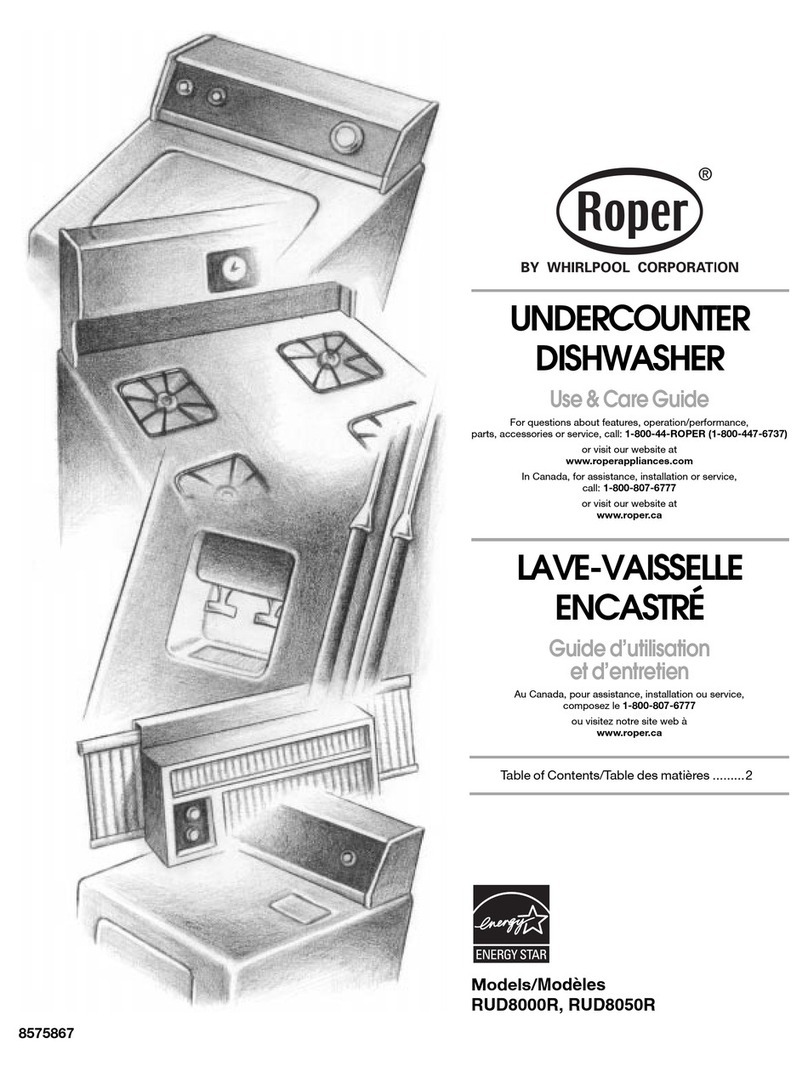
Roper
Roper RUD8000R User manual
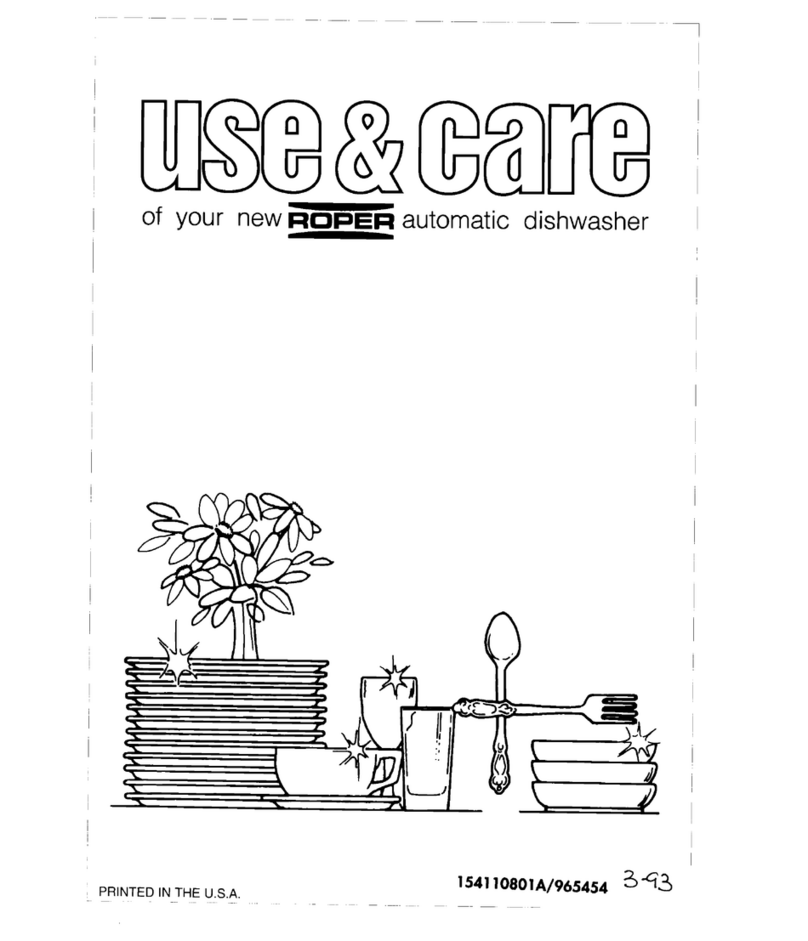
Roper
Roper Automatic Dishwasher User manual
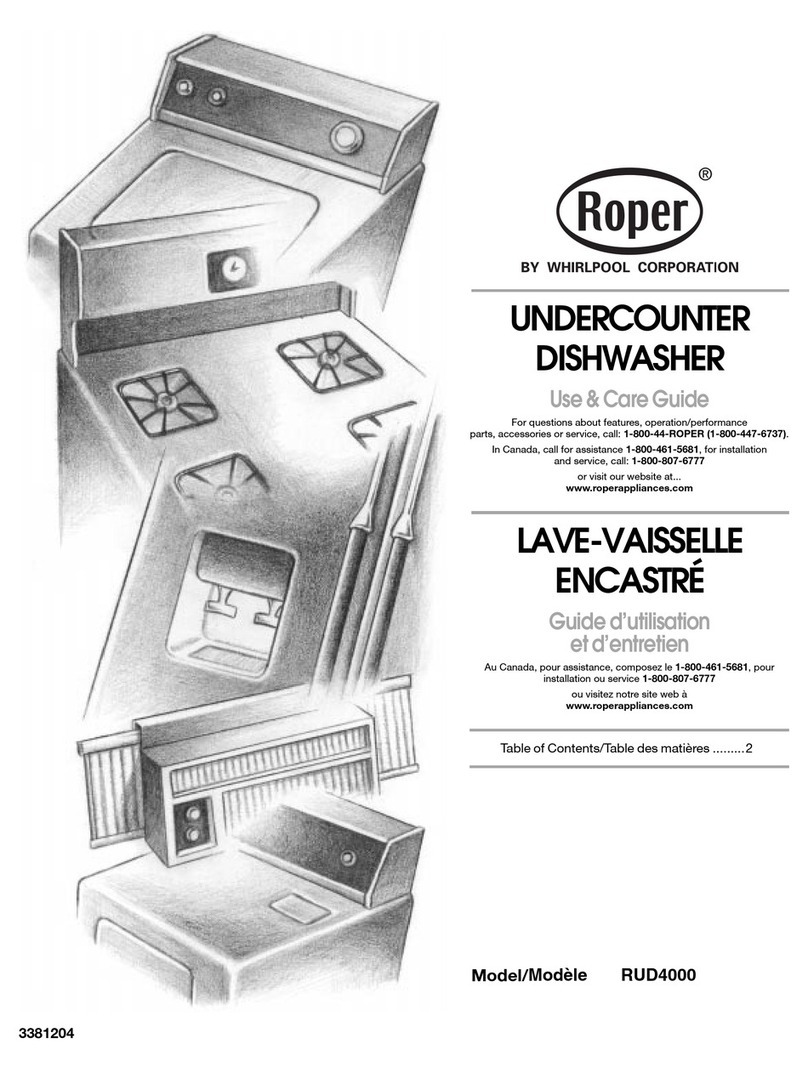
Roper
Roper rud4000 User manual

Roper
Roper 408 User manual
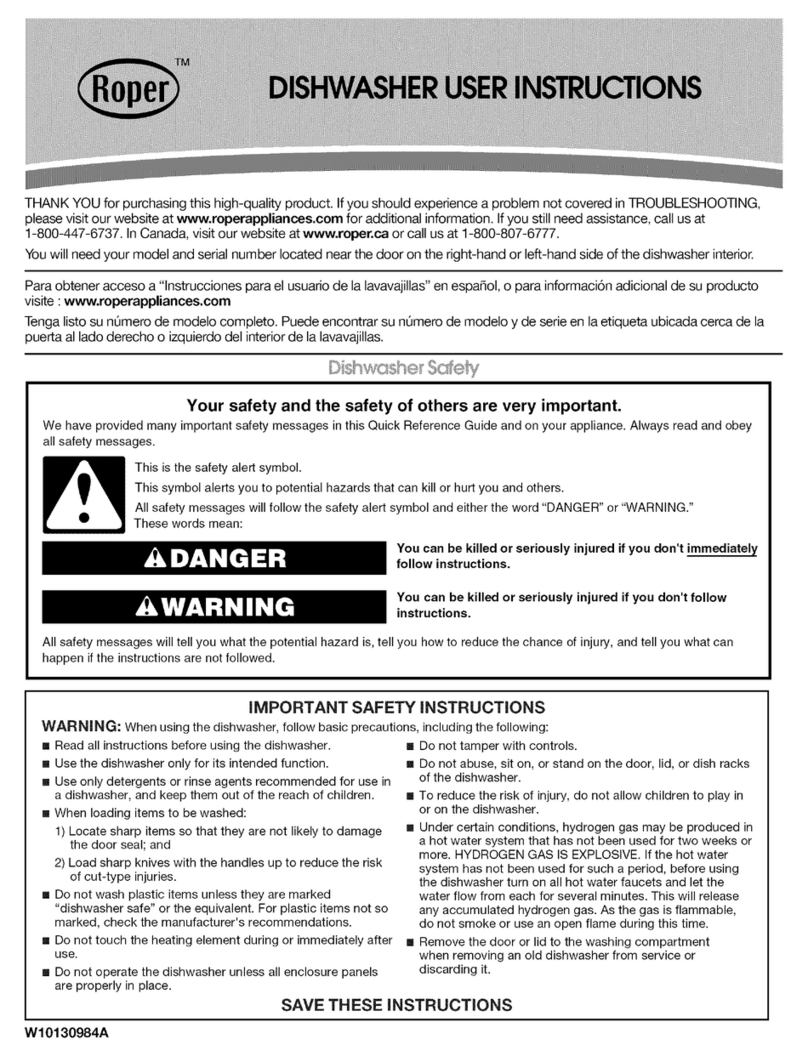
Roper
Roper RUD4000SB0 User manual

Roper
Roper WU3000V User manual

Roper
Roper RUD8000R User guide

Roper
Roper RUD8050S User manual
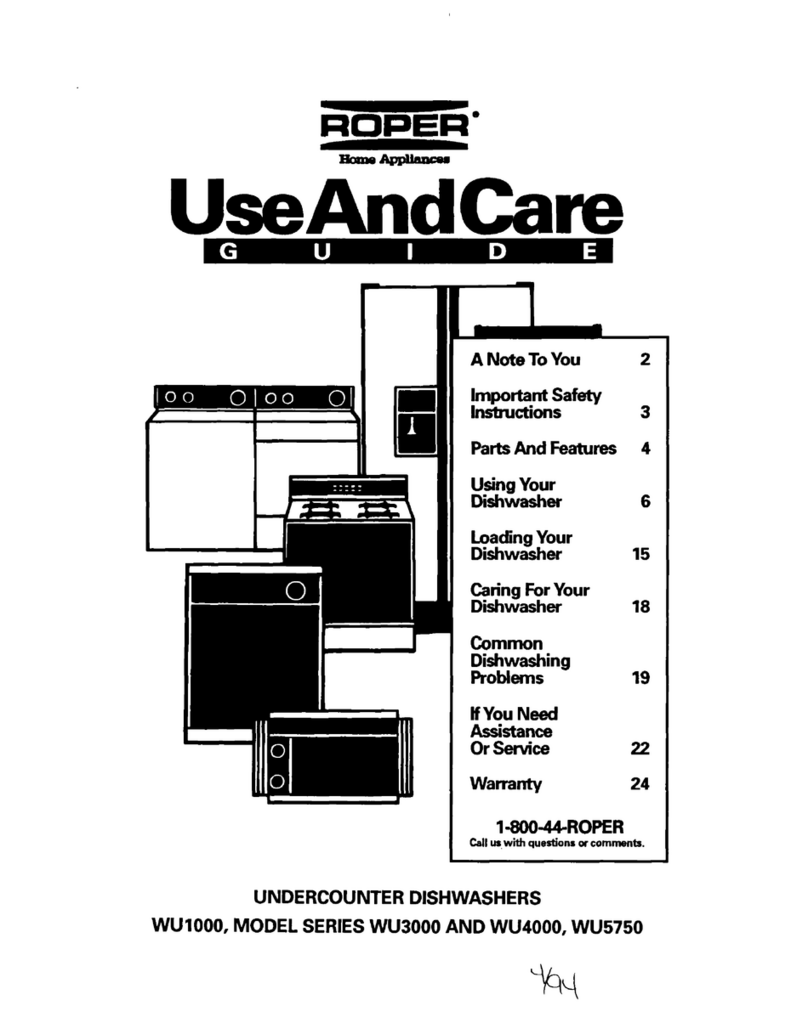
Roper
Roper WU3000 Series User manual

Roper
Roper 3376809 User manual

Roper
Roper RUD3000HB0 User manual

Roper
Roper RUD1000 User manual
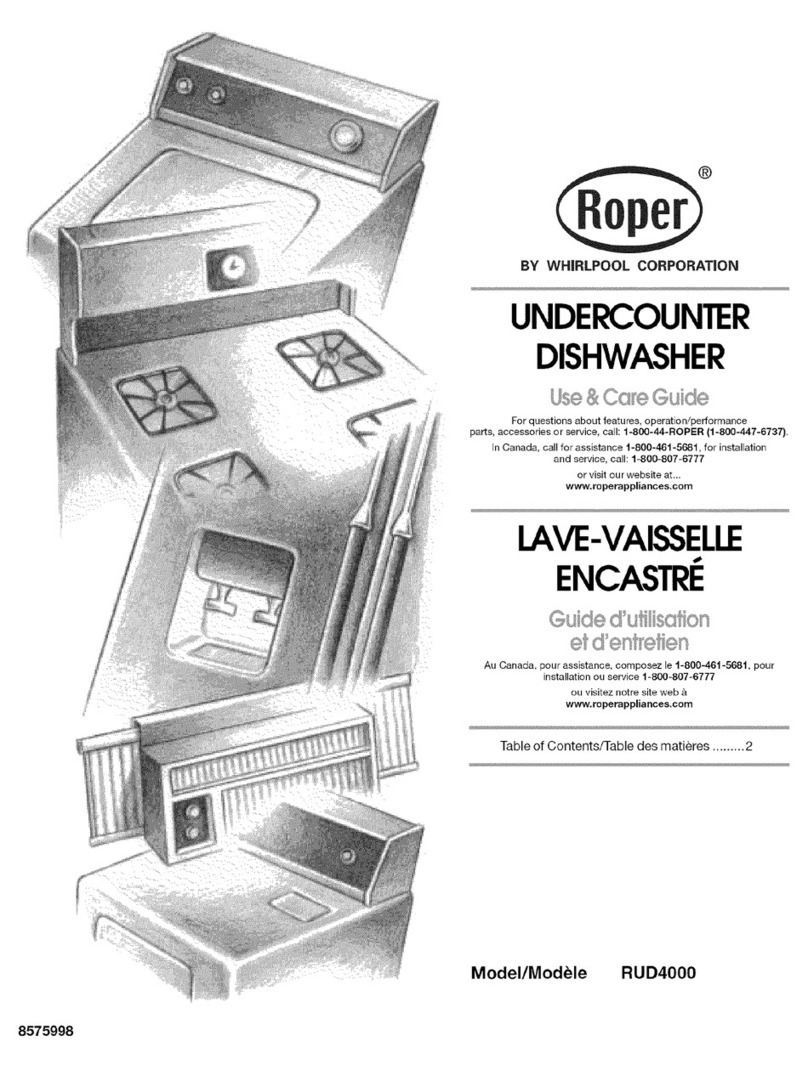
Roper
Roper RUD4500MQ2 User manual
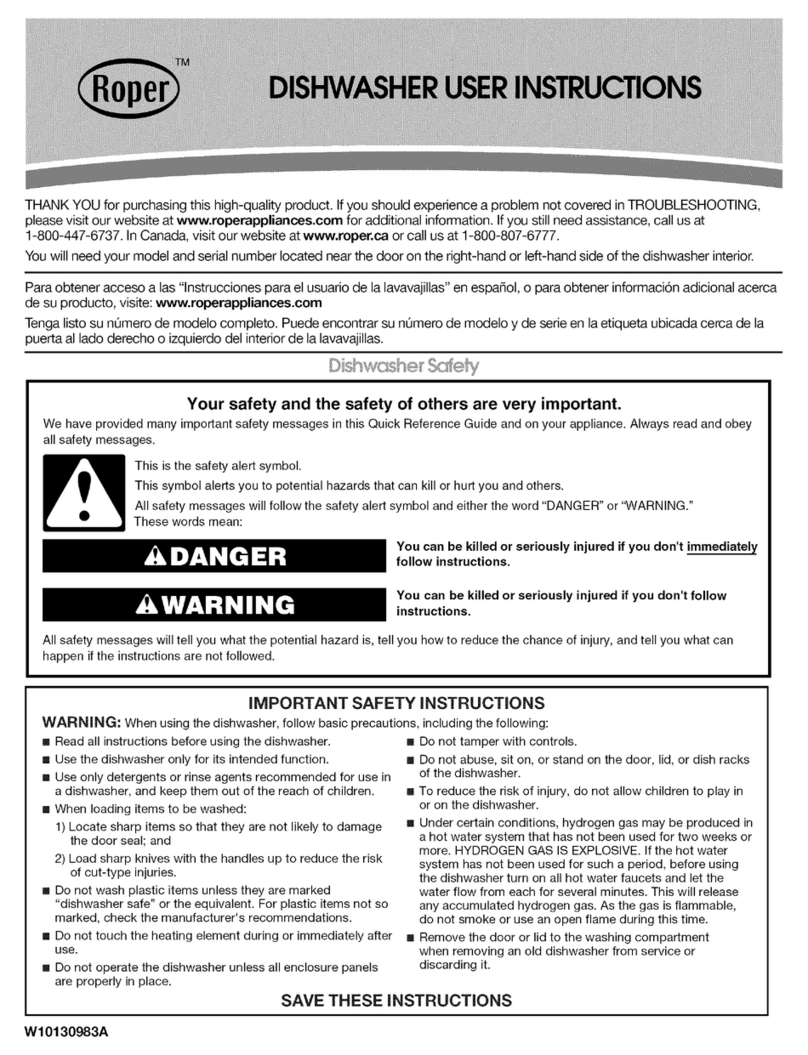
Roper
Roper RUD8050SD2 User manual

Roper
Roper RUD6050RD2 User manual
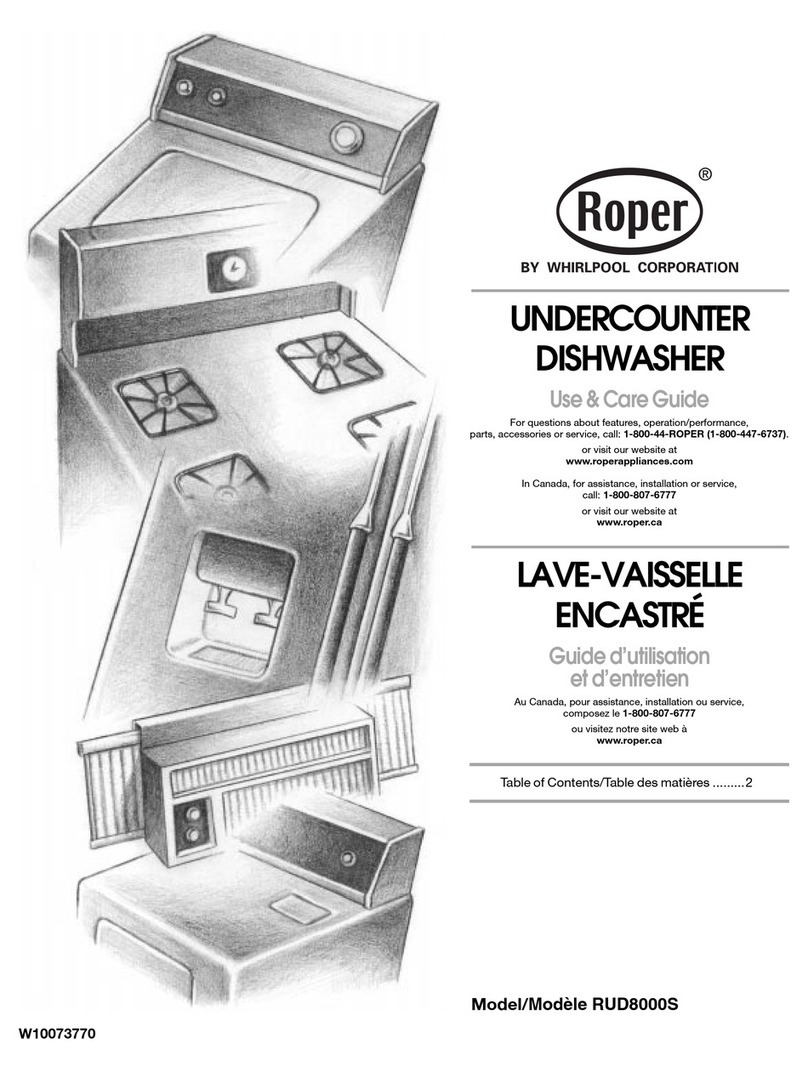
Roper
Roper RUD8000S User manual
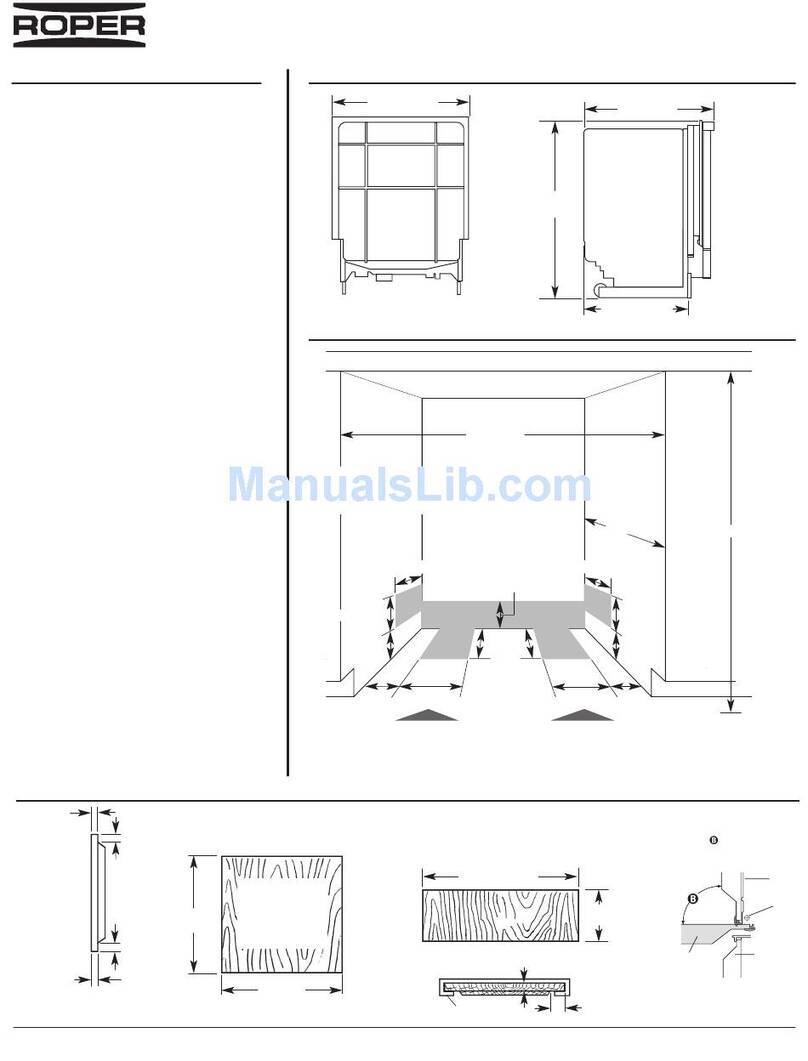
Roper
Roper RUD1000KB User instructions

Roper
Roper UNDERCOUNTER DISHWASHERS User manual

